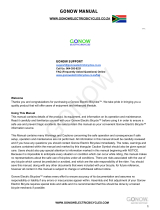
The Vienna Electric Bicycle User’s Guide
TPS Training Bulletin
Page 16
Removing the Main Battery for Charging or Storage
Your batteries can be removed for charging if you need to bring them inside while you are
stopped or waiting at a destination. This is useful if you are arriving at work and need to
allow the battery to charge before you commute home, or if you want to remove the
discharged battery and replace it with a spare battery that has been charged.
To do this, follow these steps:
1. Lift up the flexible footguard sitting on the battery compartment between the seat and
the steering shaft.
2. Unlock the battery compartment.
3. Lift the battery out part-way, turn the battery slightly and rest it against the battery
case frame.
4. Unplug the battery from the e-bike.
5. Lift the battery carefully with both hands and carefully place it somewhere convenient
and safe.
6. Carefully follow the instructions found under “Battery Care”.
When you want to place the battery back into the e-bike, reverse these steps.
Removing the Backup Battery for Charging or Storage
Because your Vienna e-bike has a double battery, the seat trunk is actually used to contain
the second, or spare, battery.
To open the seat trunk and remove the spare battery, follow this procedure:
1. Insert the key into the lock on the left side of the e-bike, just below the seat. Turn it all
the way to the right. The seat will snap open and pop up.
2. Unplug the battery from the e-bike.
3. Lift the battery out carefully, using both hands, by the straps provided, and place it
where it is to be charged.
4. Follow the instructions found under “Battery Care” and “Handling the Battery.”
When you want to place the battery back into the e-bike, reverse these steps.
To close the seat trunk, make sure that there is nothing blocking the locking mechanism,
such as items you have placed in the storage compartment, and push the seat down with
force. You will hear a “click” sound when it is properly closed.
Caution
Be careful not to disconnect the power leads that run between the
batteries when removing the spare battery from the compartment.
These wires keep the batteries in series, and allow the e-bike to draw
on the complete set as a single unit. Disconnecting the wires will
break the connection and will alter the power output of the battery unit
as a whole. If the wires become disconnected, call your Daymak
dealer immediately, before you try to service the battery.
























